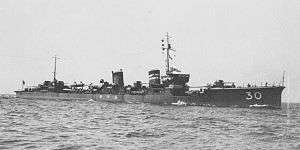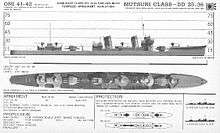Mutsuki-class destroyer
 Mutsuki in 1930 | |
| Class overview | |
|---|---|
| Name: | Mutsuki class |
| Builders: | |
| Operators: |
|
| Preceded by: | Kamikaze class |
| Succeeded by: | Fubuki class |
| Built: | 1924-1927 |
| Planned: | 12 |
| Completed: | 12 |
| Lost: | 12 |
| General characteristics | |
| Type: | Destroyer |
| Displacement: |
|
| Length: |
|
| Beam: | 9.16 m (30.1 ft) |
| Draught: | 2.96 m (9.7 ft) |
| Propulsion: |
|
| Speed: | 37.25 knots (68.99 km/h) |
| Range: | 3,600 nautical miles (6,700 km) at 14 knots (26 km/h) |
| Complement: | 154 |
| Armament: |
|
The Mutsuki-class destroyers (睦月型駆逐艦 Mutsukigata kuchikukan) were a class of twelve destroyers of the Imperial Japanese Navy.[3] All were given traditional poetic names of the months of the year by the Lunar calendar or phases of the moon. Some authors consider the Kamikaze and Mutsuki-class destroyers to be extensions of the earlier Minekaze class.[4]
Background
With the imposition of the Washington Naval Treaty limiting the number and size of capital warships, increased emphasis was placed by the Imperial Japanese Navy on the quantity and firepower of its destroyer fleet to counter what was perceived to be the growing threat from the United States Navy. The Mutsuki-class destroyers were an improved version of the Kamikaze class destroyers and were ordered under the 1923 fiscal budget.[5]
Along with the Minekaze and Kamikaze classes, the Mutsuki-class ships formed the backbone of Japanese destroyer formations throughout the twenties and thirties. The Minekaze and Kamikaze classes were withdrawn from front line service and reassigned to secondary duties towards the end of the 1930s, but the Mutsukis were retained as first line destroyers due to their range and their more powerful torpedo armament.[6] All saw combat during World War II, and none survived the war.
Initially, the Mutsuki-class ships had only hull numbers due to the projected large number of warships the Japanese navy expected to build through the Eight-eight fleet plan. This proved to be extremely unpopular with the crews and was a constant source of confusion in communications. In August 1928, names were assigned.[7]
Design

The Mutsuki-class destroyers were based on the same hull design as the previous Kamikaze class, except with a double curvature configuration of the bow, a feature which became a standard in all later Japanese destroyers.
The Mutsuki class was the first to be fitted with the newly developed 24-inch (610 mm) torpedoes, with greater range and larger warhead than previous torpedoes in the Japanese inventory. Originally Type 8 torpedoes were carried, arranged in two triple mountings. These were later replaced with the famous Type 93 "Long Lance" oxygen-propelled torpedoes during World War II.
In September 1935, many ships in the navy were severely damaged by a typhoon while on training exercises, in what was later termed the "Fourth Fleet Incident", including a number of the Mutsuki-class destroyers, which had several plates buckled and bridges wrecked. During 1936-37 the Mutsuki-class ships were retrofitted with a strengthened, more compact, bridge, with redesigned watertight shields on the torpedo mounts. With the new shields the torpedoes could be worked in all weather conditions thus extending the useful life of the class.[8]
From 1941-1942 the Mutsuki-class destroyers were refitted with the 120 mm/45 main guns reduced to two single mounts and ten Type 96 25 mm AT/AA Guns added. The minesweeping and minelaying equipment was removed and replaced with four depth charge launchers, with 36 depth charges.
In June 1944, the surviving vessels were again refit, with the number of Type 96 25 mm antiaircraft guns increased to twenty, and an additional five Type 93 13 mm AA Guns also installed.
Operational history
The Mutsuki class formed the 5th and 6th Destroyer Squadrons. Mutsuki and Kisaragi participated in the Battle of Wake Island at the start of the war, during which time Kisaragi was lost due to aircraft bombardment. The remaining eleven vessels participated in the invasions of the Philippines and Netherlands East Indies. In the subsequent Solomon Islands campaign surviving ships were exposed to considerable danger as fast transports in “Tokyo Express” missions in trying to re-supply island garrisons. Mutsuki, Nagatsuki, Kikuzuki, Mikazuki and Mochizuki were lost due to air attack in various battles in the Solomons.[9]
Surviving vessels participated in the New Guinea campaign, mostly in the role of “Tokyo Express” transports. Yayoi was lost in an air attack off New Guinea and Fumizuki in Operation Hailstone at Truk. In the final stages of the war, Uzuki was lost to US PT-boats and Satsuki and Yūzuki to an attacks and Minazuki to submarine torpedoes in the Philippines.
None of the Mutsuki-class destroyers survived the war.[10]
List of ships
| Kanji | Name | Builder | Laid down | Launched | Completed | Fate |
|---|---|---|---|---|---|---|
| 睦月 | Mutsuki DD-19 |
Sasebo Naval Arsenal, Japan | 21 May 1924 | 23 July 1925 | 25 March 1926 | Dai-19-Gō Kuchikukan (第十九号駆逐艦); renamed Mutsuki ("January") on 1 August 1928; sunk in air attack in Solomon Islands [07.47S, 160.13E] on 25 August 1942; struck 1 October 1942 |
| 如月 | Kisaragi DD-21 |
Maizuru Naval Arsenal, Japan | 3 June 1924 | 5 June 1925 | 21 December 1925 | Dai-21-Gō Kuchikukan (第二十一号駆逐艦); renamed Kisaragi (“February”) on 1 August 1928; combat loss off Wake Island [18.55N, 166.17E] on 11 December 1941; struck 15 January 1942 |
| 弥生 | Yayoi DD-23 |
Uraga Dock Company, Japan | 11 January 1924 | 11 July 1925 | 28 August 1926 | Dai-23-Gō Kuchikukan (第二十三号駆逐艦); renamed Yayoi (“March”) on 1 August 1928; sunk in air attack in Solomon Islands [08.45S, 151.25E] on 11 September 1942; struck 20 October 1942 |
| 卯月 | Uzuki DD-25 |
Ishikawajima Shipyards, Japan | 11 January 1924 | 15 October 1925 | 14 September 1926 | Dai-25-Gō Kuchikukan (第二十五号駆逐艦); renamed Uzuki (“April”) on 1 August 1928; Sunk Ormoc Bay [11.03N, 124.23E] on 12 December 1944; struck 10 January 1945 |
| 皐月 | Satsuki DD-27 |
Fujinagata Shipyards, Japan | 1 December 1924 | 25 March 1925 | 15 November 1925 | renamed Satsuki (“May”) on 1 August 1928; sunk in air attack at Manila Bay [15.35N, 120.55E] on 21 September 1944; struck 10 November 1944 |
| 水無月 | Minazuki DD-28 |
Uraga Dock Company, Japan | 24 March 1924 | 25 March 1926 | 22 March 1927 | Dai-28-Gō Kuchikukan (第二十八号駆逐艦); renamed Minatsuki (“June”) on 1 August 1928; Torpedoed in Celebes Sea [04.05N, 119.30E] on 6 June 1944; struck 10 August 1944 |
| 文月 | Fumizuki DD-29 |
Fujinagata Shipyards, Japan | 20 October 1924 | 16 February 1926 | 3 July 1926 | Dai-29-Gō Kuchikukan (第二十九号駆逐艦); renamed Fumizuki (“July”) on 1 August 1928; sunk in air attack at Truk [07.24N, 151.44E] on 18 February 1944; struck 31 March 1944 |
| 長月 | Nagatsuki DD-30 |
Ishikawajima Shipyards, Japan | 16 April 1925 | 6 October 1926 | 30 April 1927 | Dai-30-Gō Kuchikukan (第三十号駆逐艦); renamed Nagatsuki (“September”) on 1 August 1928; combat loss in central Solomons [08.02S, 157.12E] on 6 July 1943; struck 1 November 1943 |
| 菊月 | Kikuzuki DD-31 |
Maizuru Naval Arsenal, Japan | 15 June 1925 | 15 May 1926 | 20 November 1926 | Dai-31-Gō Kuchikukan (第三十一号駆逐艦); renamed Kikuzuki (“September”) on 1 August 1928; sunk in air attack at Tulagi [09.07S, 160.12E] on 4 May 1942; struck 25 May 1942. Later salvaged by USS Menominee (AT-73), 6 October 1943. |
| 三日月 | Mikazuki DD-32 |
Sasebo Naval Arsenal, Japan | 21 August 1925 | 12 July 1926 | 5 May 1927 | Dai-32-Gō Kuchikukan (第三十二号駆逐艦);renamed Mikazuki (“Crescent Moon”) on 1 August 1928; sunk in air attack at Cape Gloucester [05.27S, 148.25E] on 29 July 1943; struck 15 October 1943 |
| 望月 | Mochizuki DD-33 |
Uraga Dock Company, Japan | 23 March 1926 | 28 April 1927 | 31 October 1927 | Dai-33-Gō Kuchikukan (第三十三号駆逐艦); renamed Mochizuki (“Full Moon”) on 1 August 1928; sunk in air attack in central Solomons [05.42S, 151.40E] on 24 October 1943; struck 5 January 1944 |
| 夕月 | Yūzuki DD-34 |
Fujinagata Shipyards, Japan | 27 November 1926 | 4 March 1927 | 25 July 1927 | Dai-34-Gō Kuchikukan (第三十四号駆逐艦) renamed Yūzuki (“Evening Moon”) on 1 August 1928; sunk in air attack at Cebu [11.20N, 124.10E] on 12 December 1944; struck 10 January 1945 |
References
Notes
- ↑ Yayoi was equipped 2 x Metropolitan-Vickers geared turbines. Nagatsuki was equipped 2 x Escher Wyss & Cie Zoelly geared turbines.
- ↑ Kikuzuki, Mikazuki, Mochizuki and Yūzuki were equipped 2 x paravanes.
- ↑ Jentsura, Warships of the Imperial Japanese Navy, 1869-1945
- ↑ Jones, Daniel H. (2003). "IJN Minekaze, Kamikaze and Mutsuki class Destroyers". Ship Modeler's Mailing List (SMML.
- ↑ Globalsecurity.org, IJN Mutsuki class destroyers
- ↑ Evans. Kaigun: Strategy, Tactics, and Technology in the Imperial Japanese Navy
- ↑ Nishida, Hiroshi. "Materials of IJN: Mutsuki class destroyer". Imperial Japanese Navy.
- ↑ Juntsura. Warships of the Imperial Japanese Navy, 1869–1945
- ↑ Morison. The Struggle for Guadalcanal, August 1942 – February 1943
- ↑ Brown. Warship Losses of World War Two
Books
- Evans, David (1979). Kaigun: Strategy, Tactics, and Technology in the Imperial Japanese Navy, 1887-1941. US Naval Institute Press. ISBN 0-87021-192-7.
- Brown, David (1990). Warship Losses of World War Two. Naval Institute Press. ISBN 1-55750-914-X.
- Howarth, Stephen (1983). The Fighting Ships of the Rising Sun: The Drama of the Imperial Japanese Navy, 1895–1945. Atheneum. ISBN 0-689-11402-8.
- Jentsura, Hansgeorg (1976). Warships of the Imperial Japanese Navy, 1869–1945. US Naval Institute Press. ISBN 0-87021-893-X.
- Morison, Samuel Eliot (1958). The Struggle for Guadalcanal, August 1942 – February 1943, vol. 5 of History of United States Naval Operations in World War II. Boston: Little, Brown and Company. ISBN 0-316-58305-7.
- Nelson, Andrew N. (1967). Japanese–English Character Dictionary. Tuttle. ISBN 0-8048-0408-7.
- Watts, Anthony J (1967). Japanese Warships of World War II. Doubleday. ASIN B000KEV3J8.
- Whitley, M J (2000). Destroyers of World War Two: An International Encyclopedia. London: Arms and Armour Press. ISBN 1-85409-521-8.
External links
| Wikimedia Commons has media related to Mutsuki class destroyers. |
- Nishida, Hiroshi. "Materials of IJN: Mutsuki class destroyer". Imperial Japanese Navy.
- Globalsecurity.org. "IJN Mutsuki class destroyers".
- Jones, Daniel H. (2003). "IJN Minekaze, Kamikaze and Mutsuki class Destroyers". Ship Modeler's Mailing List (SMML).